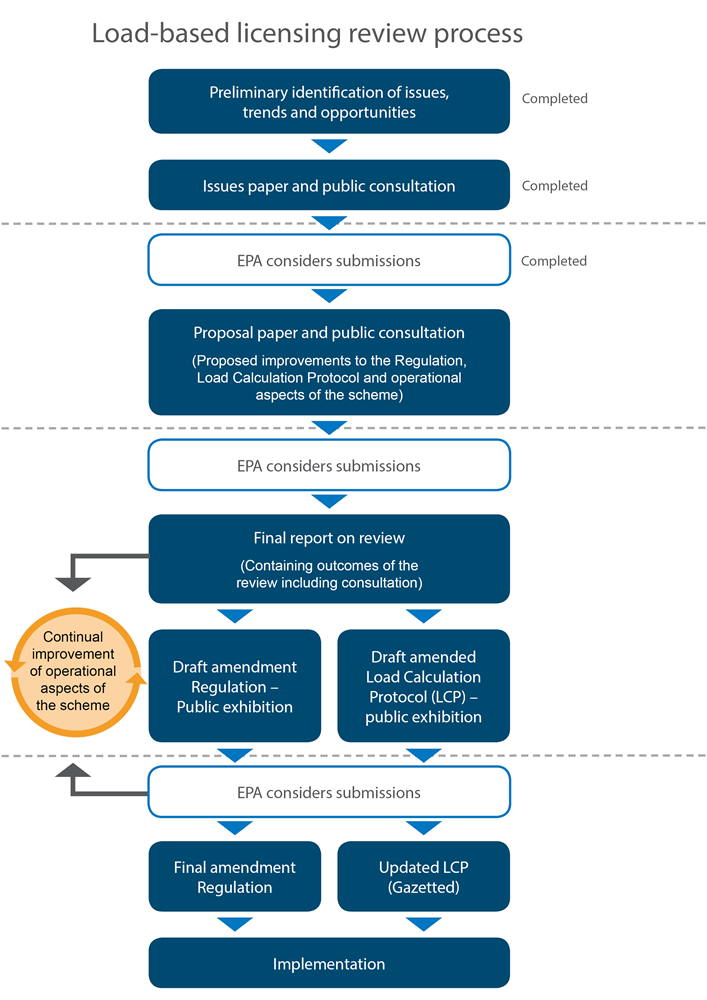Review of the load-based licensing scheme
The Environment Protection Authority (EPA) is currently reviewing the load-based licensing (LBL) scheme. The scheme has been in operation since 1999 and this review of its effectiveness and efficiency aims to ensure it is fulfilling its potential.
Load-based licensing issues paper: submission period closed
The EPA sought public feedback on an issues paper (PDF 2.2MB) for the LBL review between 31 October and 23 December 2016. The submission period for the issues paper has now closed. To contact the LBL review team, please email [email protected].
The purpose of the issues paper is to provide information about the performance of the LBL scheme and to seek stakeholders’ feedback to inform a comprehensive review of the scheme’s efficiency and effectiveness to date. The paper looks at the LBL scheme in detail, identifies a range of issues and various options for its improvement, and also considers feedback already received, including via a preliminary survey of LBL licensees.
The issues paper snapshot (PDF 867KB) provides an overview of the issues paper, including the key issues covered and the options for change put forward for consideration.
The document NSW EPA’s Load-based Licensing Scheme: Overview and facts about load-based licensing (PDF 1MB) gives an overview of how the LBL scheme works.
The EPA commissioned two consultancies to inform the development of the issues paper. The first was a comparative review of load-based licensing systems (PDF 2.1MB) by BDA Group. The second was a load-based licence fee comparison (PDF 1.4MB) by ACIL Allen. The issues paper describes the purpose and outcomes of these two consultancies in detail.
Stakeholder submissions
Fifty two submissions on the LBL Issues Paper (PDF 2.2MB) were received.
- 350org Australia (PDF 241KB)
- Australian Council of Recycling (PDF 84KB)
- Australian Energy Council (PDF 298KB)
- Australian Pork Limited (PDF 249KB)
- Australian Sustainable Business Group (PDF 1.2MB)
- Cement Concrete and Aggregates Australia (PDF 4.1MB)
- Central Coast Council (PDF 1.1MB)
- Central West Environment Council (PDF 85KB)
- Charlotte McCabe (PDF 48KB)
- Clean Air Society of Australia and New Zealand NSWACT Branch (PDF 83KB)
- CMOC Northparkes Mines (PDF 207KB)
- Delta Electricity (PDF 808KB)
- Doctors for the Environment (PDF 328KB)
- EDO NSW (PDF 459KB)
- EnergyAustralia (PDF 103KB)
- Glencore Coal Assets Australia Pty Limited (PDF 623KB)
- Goulburn River Stone Cottages (PDF 335KB)
- Hawkesbury City Council (PDF 68KB)
- Hunter Environment Lobby (PDF 53KB)
- Hunter Water (PDF 605KB)
- Judith Leslie (PDF 686KB)
- Kerry Penrose (PDF 70KB)
- Kyogle Council (PDF 46KB)
- Local Government NSW (PDF 211KB)
- Lock the Gate Alliance (PDF 404KB)
- Muswellbrook Shire Council (PDF 680KB)
- Nature Conservation Council (PDF 487KB)
- Newcastle University Student Environment Club (PDF 45KB)
- NSW Business Chamber (PDF 287KB)
- NSW Department of Primary Industries (PDF 319KB)
- NSW Farmers (PDF 185KB)
- NSW Health (PDF 170KB)
- NSW Minerals Council (PDF 678KB)
- NSW Water Directorate (PDF 895KB)
- Peabody Energy (PDF 173KB)
- Port Kembla Pollution Meeting Committee Submission No1 (PDF 17KB)
- Port Kembla Pollution Meeting Committee Submission No2 (PDF 23KB)
- Rio Tinto Coal Australia (PDF 117KB)
- Sharyn Munro (PDF 51KB)
- Shoalhaven City Council (PDF 1.6MB)
- Sims Metal Management (PDF 983KB)
- Singleton Shire Healthy Environment Group (PDF 2.1MB)
- SUEZ Recycling and Recovery (PDF 232KB)
- Sydney Trains (PDF 434KB)
- Sydney Water (PDF 493KB)
- WJ & A Seery Partnership (PDF 266KB)
- Yancoal Australia (PDF 436KB)
- Community group - confidential
- Company - confidential
- Company - confidential
- Company - confidential
- Individual - confidential
Next steps
The EPA will prepare a proposal paper for further public consultation that takes into account the comments and views received on the issues paper. This proposal paper will set out any recommended changes to improve the LBL scheme and will also include a cost–benefit analysis and an assessment of the likely financial impacts on licensees.
Objectives of the review
The objectives of the LBL review are
- to assess whether changes are needed to ensure the scheme achieves its objectives as per clause 13 of the Protection of the Environment Operations (General) Regulation 2009 which states
- to improve the effectiveness of the LBL scheme in driving reductions in air and water pollutant emissions
- to improve the efficiency and ease of use of the scheme for licensees and the EPA
- to ensure the scheme has a complete range of tools.
Outline of the review process
The LBL review has four key deliverables
- An issues paper to allow for public consultation, including discussion of key issues, trends, LBL licensee survey results, and options for improvements. [Completed]
- A proposal paper, including a more refined proposal for improving the LBL scheme based on further analysis and stakeholder feedback from the issues paper.
- A final report, including final recommendations for improving the LBL scheme and proposed amendments, including
- a draft amendment regulation for public exhibition
- a draft amended Load Calculation Protocol for public exhibition.
- A final amendment package, including
- a Better Regulation Statement, if the proposed changes are significant, to be published on the EPA’s website
- the final amendment regulation to be published on the Legislation NSW website
- the final amended load calculation protocol to be published in the NSW Government Gazette
Flow diagram: Load based licensing review process

Stay informed
If you would like to be kept informed of the progress of the LBL review, please provide your contact details to the LBL review team. You can also use this email address to raise specific issues about the LBL scheme with the EPA or seek more information.